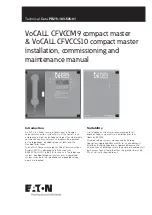
3
Technical Data
PR211-183-505-01
VoCALL CFVCCM9 compact master
EATON
www.eaton.com
Unpacking the VoCALL CFVCCS10
compact slave unit
Remove the VoCALL Compact unit from its packing, and check
the contents against the following list:
1. VoCALL CFVCCS10 Compact slave unit.
2. Installation & maintenance manual (this document).
3. User guide & logbook.
4. Accessory pack with the following contents:
a. Spare mains fuse.
b. 2.5 mm AF ALN key.
Using the ALN key supplied, open the front cover.
Verify the following items are present:
1. 10 off outstation line connectors
2. 1 off 4 way network connector
If there are any Items missing please contact your supplier or
Cooper Safety Fire Systems, quoting the unit serial number,
and the name on the packing list enclosed so we can rectify
the situation.
Preparation
Remove the front door plate containing the circuit board by
unscrewing the door hinge. This has a connection to the base
PCB, which needs to be removed. Exercise static precautions
to prevent damage to the electronics. Store the front panel
assembly safely until the master handset is mounted and
cables have been attached.
Before mounting the unit on the wall it is advisable to remove
the cable knockouts. Decide how the wiring will be brought into
the panel and remove the required knockouts for cable entry. If a
knockout is removed, fill the hole with a good quality cable gland.
On the bottom face a single knockout is for the incoming mains.
Mains SHOULD NOT enter the box by any other hole. If additional
holes are required, then the can be drilled as shown below, taking
care not to obscure the battery or PCB locations.
Unused knockouts must be left unopened to comply with the LVD.
Accidentally knocked out holes should be blanked off. This work
must be carried out prior to the re-installation of circuit boards.
Mounting VoCALL compact unit
The VoCALL Compact unit weighs 4Kgs with batteries, so care
should be taken to securely mount the unit on stud walling.
Connecting VoCALL compact unit
To comply with EMC (Electro Magnetic Compatibility) regulations
and to reduce the risk of electrical interference in the system
wiring, we recommend the use of fire-resistant screened cables
throughout the installation.
All wiring should come into the enclosure via the knockouts
provided, and be fixed tidily to the relevant terminals.
Note that correct cable glanding is essential and due regard
should be paid to any system specifications which demand a
certain cable type (providing it meets the appropriate national
wiring regulations).
Planning the wiring
All system wiring should be installed to meet the appropriate
parts of BS5839-9 (2011) and BS 7671 (Wiring Regulations).
Other national standards of installation should be adhered to
where applicable.
Do not test wiring with an insulation tester (Megger) with any
equipment or outstations connected, as the 500 Volt test voltage
will destroy these devices totally.
You must observe local wiring regulations. Do not run SELV
and LV cables in the same enclosure without adequate
insulation between them.































